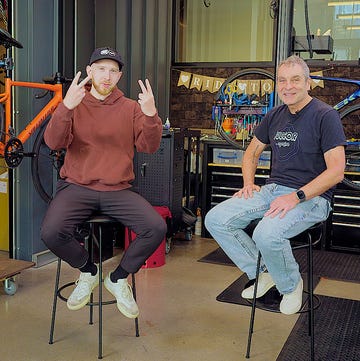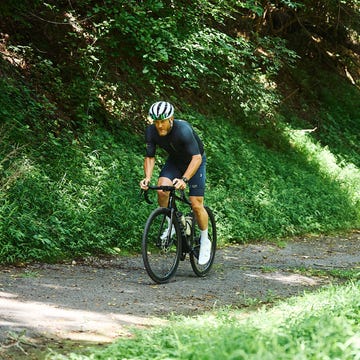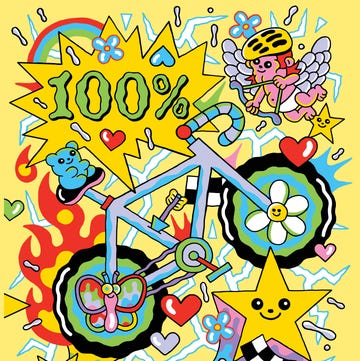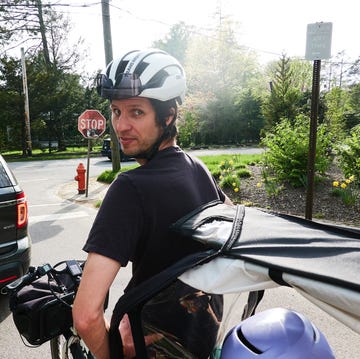I’ve had the privilege of involving myself in a few populous and dramatically different cycling communities. I grew up surrounded by fervent mountain bikers in central Pennsylvania, I toed the line with gaggles of aspiring pros in junior races near Lancaster, and I watched Penn State’s cycling club expand from a dozen members to hundreds in less than a year. Now, I split my time between the avid roadies who live near Bicycling’s office and the quirky, resilient city riders of Philadelphia, where I live. At a glance, these communities don’t have much in common beyond a love for bikes, yet I’ve loved being part of all these communities just the same.
So, what gives? How do scenes like these form on their own without some sort of blueprint for success? Is it infrastructure? I’ve seen mountain bikers form a community next to 10 miles of trails just as easily as others did next to thousands. Is it an abundance of cyclists? I’ve seen riding groups form in towns with populations as low as 3,400. Does a local event bind the community together? Most years, my college’s cycling club had to travel to other states just to race. I struggle to say any of these criteria are essential to a scene: These communities may never develop into a new “cycling city” like Boulder, Colorado, or Eugene, Oregon, both of which are famous for their expansive bike infrastructure and athletic population. But for those involved in a good riding group, it doesn’t matter. Hell, we have to squeeze through a sketchy, shoulder-wide gap on a highway bridge every time we go out for an office lunch ride. But that doesn’t stop a proper group of cyclists with multiple skill levels from meeting us downtown at noon.
The strongest indicator I’ve found for a cycling scene’s success is its enthusiasm for newcomers. I don’t mean seasoned cyclists moving to a new area—I mean people who want to get into riding for the first time. In turn, the cycling scenes I’ve seen shrink the fastest were the ones dedicated to weeding out anyone but the most serious riders, kicking wide-eyed newbies to the curb.
The mountain biking scene around State College, Pennsylvania, was always sizable during the time I grew up there, but it ballooned when new clubs formed that focused on introducing people to the sport. One catered only to women, and another took pride in its slow, easy trail rides that met weekly and dropped nobody. When they formed, I was a mechanic at the local bike shop, and I heard plenty of gossip from the local elitists about how they thought these groups would kill the vibe. “Nobody’s gonna want to wait for them,” they said.
In reality, all those new riders were more than happy to wait for each other on the trail. They were elated to get outside and hone a new skill in the massive expanse of woods next to town. Because they were new and rough around the edges, they were blissfully unaware of any artificial criteria for what made someone a worthy mountain biker. As a result, they never gave up when they took a bad line in a rock garden, and plenty of them became smoother trail riders than me in a fraction of the time.
I know the inverse of this rule is true, too: I’ve seen a struggling community shrink when it prioritized competition and exclusivity. In college, my school’s cycling club varied dramatically in size from year to year. When I started at Penn State, the small club was hell-bent on getting a team to national championships. Few other priorities. Those years, we hardly had enough members to keep the club official. In contrast, when we marketed the club to every kid we saw farting around with a bike on campus, more than 200 people came to our first meeting of the semester. And we had one of the liveliest years of riding and racing the club had ever seen. We even resurrected a collegiate mountain bike race that hadn’t run since before I was a teenager, and hundreds more riders from a dozen other schools showed up to compete in it.
In short, new riders don’t aspire to become assholes who say you’re not a cyclist until you’re fast. Those bad actors kill a community, especially when they can move the goalpost that defines “fast.” Each community I’ve met that has survived more than a few years invites everyone to the party who can ride there. Even my junior racing team, which was brutally competitive at almost every event, didn’t hesitate to let me join their ranks when I showed up clueless to my first race against them (which I lost resoundingly). They didn’t draw me in because they were fast—they drew me in because they were nice. And I was looking for a home far more than a podium spot.
Adam Schram is an Assistant Editor of Commerce at Runner's World, though you might see his byline on Bicycling and Popular Mechanics, too. A lover of all things outdoors, Adam's writing career comes after six years as a bike mechanic in his hometown of State College, PA. His journalism experience is steeped in cycling and running gear reviews, and he's also a published creative nonfiction and satire author. When he's not writing, riding, or running, you can catch Adam at home mixing cocktails, watching Star Wars, or trying in vain to do the Sunday crossword. You can check out his latest work below.













